Everything about an expansion tank for water supply: operating principle, types, self-assembly
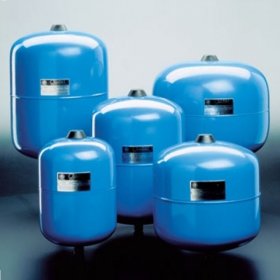
An autonomous water supply system today does not surprise anyone. Such designs are very convenient and practical, but for their operation, often, devices are required that a person who uses only a centralized water supply system may simply not know. For example, an autonomous water supply system will operate smoothly for a long time only if an expansion tank for water supply is included in it. Modern industry produces many different models of such devices. In order to choose the best option for yourself, you need to navigate the types of equipment and have a good idea of the principle of its operation.
Content
The device and functions of this equipment
Expansion tank Designed to maintain pressure in the water supply system. Most often, closed-type membrane equipment is used for water supply. It is a container inside which a rubber membrane is installed. She divides the device into two cameras: air and water. After starting the system, the electric pump fills the last with water. The volume of the air chamber is reduced. The smaller the volume of air in the tank, the higher the pressure.
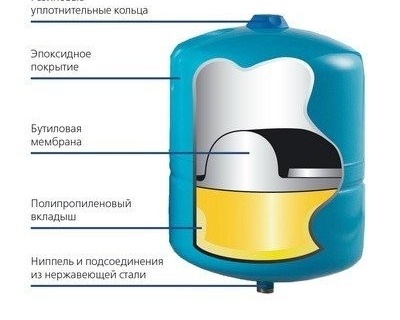
As an expansion tank for the water supply system, a membrane-type design is used. The rubber diaphragm divides the device into two cameras: air and water
As soon as it exceeds the programmed mark, the pump will automatically shut off. It will turn on only after the pressure drops below the minimum programmed mark, while the water will begin to flow from the water chamber of the tank. The cycle "off-on" is repeated automatically. The pressure in the system can be checked by a pressure gauge that can be installed on the equipment. The device can be configured by selecting the preferred operating pressure range.
The membrane expansion tank installed in the water supply system performs several functions at once:
- Maintains pressure when the pump is off.
- Protects the system from possible water hammer caused by power surges or air entering the pipeline.
- Keeps a certain amount of water under pressure.
- Protects pumping equipment from premature wear.
The use of an expansion tank makes it possible, with low water consumption, not to turn on the pump, but to cover the water needs with the liquid stored in the tank.
You may also find useful material on how to properly regulate the water pressure in the water supply system using a relay:https://aquatech.tomathouse.com/en/vodosnab/nasos/nasos-stancii/regulirovka-rele-davleniya-dlya-nasosa.html
Types of Membrane Tanks
There are two main types of expansion membrane equipment.
Replaceable membrane device
The main distinguishing feature is the ability to replace the membrane. It is taken out through a special flange which is supported on several bolts. It should be borne in mind that in large-volume devices to stabilize the membrane, it is additionally fixed with the back to the nipple. Another feature of the device is that the water filling the tank remains inside the membrane and does not contact the inside of the tank. This protects metal surfaces from corrosion, and the water itself from possible contamination and significantly extends the life of the equipment. Such models are available, both in horizontal and vertical versions.
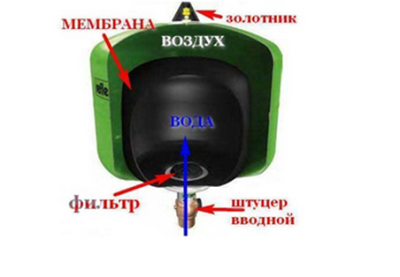
Replaceable diaphragm devices have a longer service life, since the most vulnerable element of the system can be replaced and water does not come into contact with the metal case of the device
Fixed diaphragm device
In such devices, the inside of the tank is divided into two parts by a rigidly fixed membrane. It cannot be replaced, therefore, if it fails, the equipment will have to be changed. In one part of the device, air is contained, in the other - water, which is in direct contact with the internal metal surface of the device, which can provoke its rapid corrosion. To prevent the destruction of metal and water pollution, the inner surface of the water part of the tank is coated with a special paint. However, such protection is not always durable. Devices of horizontal and vertical types are available.

A kind of device with a rigidly fixed membrane. The design assumes that the water is in contact with the walls of the equipment
Our next article presents expert recommendations for choosing a membrane tank:https://aquatech.tomathouse.com/en/voprosy/podbor-membrannogo-baka-dlya-povysitelnoj-nasosnoj-ustanovki.html
How to choose the right device?
The main characteristic on the basis of which the equipment is selected is its volume. In this case, the following factors must be taken into account:
- The number of people using the water supply system.
- The number of water intake points, which include not only showers and taps, but also household appliances, such as washing machines and dishwashers.
- The likelihood that water will be consumed by several consumers at the same time.
- The maximum number of start-stop cycles per hour for installed pumping equipment.
Experts recommend using the following indicators as a guideline when choosing an expansion tank:
- If the number of consumers does not exceed three people, and the installed pump has a capacity of up to 2cub. m per hour, a tank with a volume of 20 to 24 liters is selected.
- If the number of consumers is from four to eight people and the pump capacity is within 3.5 cubic meters. m per hour a tank of 50 l is installed.
- If the number of consumers is more than ten people and the productivity of pumping equipment is 5 cubic meters. m per hour, choose a 100 l expansion tank.
When choosing the right model of the device, it is worth considering that the smaller the volume of the tank, the more often the pump will turn on. And also the fact that the smaller the volume, the greater the likelihood of pressure surges in the system. In addition, the equipment is also a reservoir for storing a certain supply of water. Based on this, the volume of the expansion tank is also adjusted. You should know that the design of the device allows the installation of an additional tank. Moreover, this can be done during the operation of the main equipment without laborious dismantling. After the installation of a new device, the volume of the tank will be determined by the totality of volumes installed in the system of tanks.
In addition to technical characteristics, choosing an expansion tank, special attention should be paid to its manufacturer.The pursuit of cheapness can result in much more substantial costs. Most often, the cheapest materials are used to produce models that are attractive for their value, and, as practice shows, they are not always of high quality. Of particular importance is the quality of the rubber from which the membrane is made. Not only the service life of the tank, but also the safety of the water that comes from it directly depends on this.
When buying a tank with a replaceable membrane, you must definitely clarify the cost of the consumable element. Very often in the pursuit of profit, bona fide manufacturers do not always significantly increase the price of a replacement membrane. In this case, it will be more appropriate to choose a model of another company. Most often, a large manufacturer is ready to be responsible for the quality of their products, as they value their reputation. Thus, it is worth first of all to consider models of just such brands. These are Dzhileks and Elbi (Russia) and Reflex, Zilmet, Aquasystem (Germany).
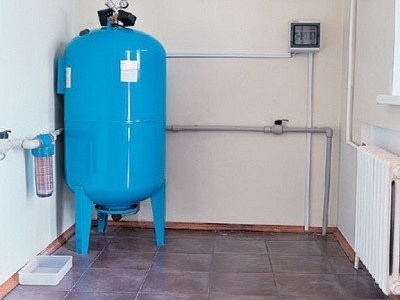
The volume of the expansion tank for water supply can be different, it is selected based on the needs of users. If more volume is subsequently required, an additional device can be installed.
Features of self-installation
All expansion tanks can be divided into two groups, determined by the connection method. Distinguish between vertical and horizontal models. There are no particular differences between them. When choosing, they are guided by the parameters of the room where the equipment will be placed. During installation, you should adhere to such recommendations:
- The expansion tank is installed so that it can be provided with unhindered access for maintenance.
- It is necessary to provide for the possible subsequent dismantling of the connecting pipe for the replacement or repair of equipment.
- The diameter of the connected water supply can not be less than the diameter of the pipe.
- It is necessary to ground the device, so electrolytic corrosion can be avoided.
The device is mounted on the suction side of the pump. In the interval between the pumping equipment and the connection point, it is necessary to exclude all elements that are capable of introducing significant hydraulic resistance into the system. We connect the make-up line to the circulation circuit of the entire system.
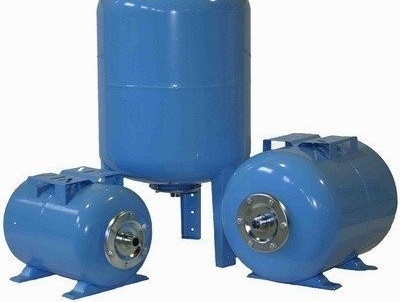
By the type of installation, expansion tanks of horizontal and vertical connection are distinguished
Also pay attention to the material about what malfunctions most often occur in pumping stations, and how to fix them yourself:https://aquatech.tomathouse.com/en/vodosnab/nasos/nasos-stancii/remont-nasosnoj-stancii-svoimi-rukami.html
An expansion tank is an integral part of an autonomous water supply system. He supports required pressure in the system, prevents premature damage to the pump and maintains a certain supply of water. However, all these functions are performed only under the condition of competent selection and proper installation of the structure. Therefore, in the absence of experience, it is better not to get involved in amateur performances, but to find qualified specialists who will qualitatively install any device.

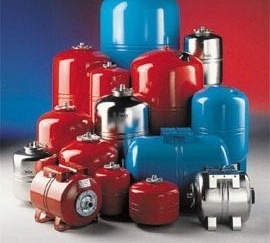
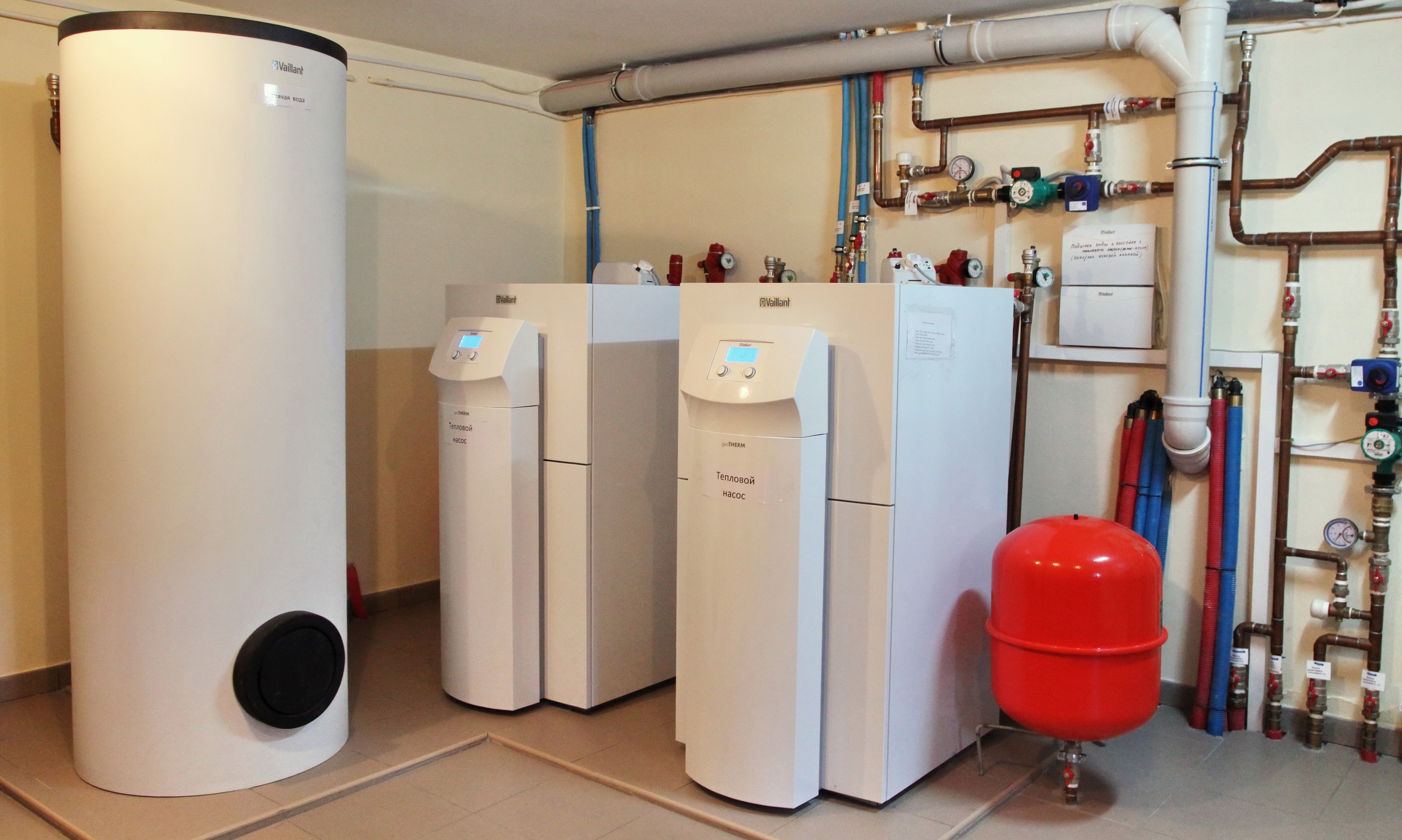
2 comments